'The day Chandrayaan-2 failed to soft land, we identified what went wrong.'
'On that day itself, we knew what corrective actions had to be taken.'

If Chandrayaan-1 happened when Dr G Madhavan Nair was the chairman of ISRO, India's second Moon mission, Chandrayaan-2 was launched under then ISRO chairman Dr Kailasavadivoo Sivan.
Though it failed to soft land on the south pole of the moon, the rover is still active.
Like Dr Madhavan Nair then told Rediff.com, "It will be used as a relay station for Chandrayaan-3."
Dr Sivan is delighted that what began in 2019 has become a success with Chandrayaan-3.
"We have achieved many things yesterday. Today, we achieved this. Tomorrow, it will be something else. So, you cannot say this is the most successful mission. Each mission, each technology has its own difficulties and challenges," Dr Sivan tells Rediff.com's Shobha Warrier in a fascinatinc conversation.

Were you nervous while watching the last leg of the Chandrayaan-3 mission?
We were anxious. And not just in the last few minutes, there will be anxiety during the entire duration.
Was it because of what happened to Chandrayaan-2 that you were anxious?
It has nothing to do with Chandrayaan-2 or Chnadrayaan-3. Every space mission has its own risks and complexities. So, we feel anxious with every mission.
Finally when it soft landed without any problem, how did you feel?
I was extremely happy that it landed without any problem. Not just me, all of us were very happy and relieved. It was a very, very, happy and proud moment.
I was at there at the control complex when the landing happened.

After Chandrayaan-2 failed in its landing, what was the motivating factor for the entire team to come back and work on the mistakes?
There will be some problem for every mission, but once you realise the problem, we go back to the table immediately and try to understand what went wrong. Then, we try to correct it.
Once you start working, you forget about the failure. It is like working on a new project.
This is the usual practice.
As the chairman, as the leader, did you have to take the initiative and motivate the team?
Of course. When the morale of the team is down, it is the responsibility of the Chairman to boost their morale and bring them back to normalcy.
I tried to explain to them that there was no need to worry, and that we would succeed the next time. I would tell them, 'It is time for you to go back to work forgetting the past.'
The day Chandrayaan-2 failed to soft land, we identified what went wrong. On that day itself, we knew what corrective actions had to be taken.
So, you can say the work for Chandrayaan-3 started on the day Chandrayaan-2 failed to land on the Moon.

It took four years for the Chandrayan-3 mission...
Like I said, we identified the areas where we had to improve on that day itself. Subsequently, in the last four years, all the new ideas were implemented, tested and simulated to see everything was alright.
Was the team confident of success this time?
Not just this time, before every mission, the team will be and has to be confident. Unless the team is confident, a mission will not happen.
Of course, Chandrayaan-3 turned out to be a successful mission.

Was soft landing the most challenging part of the Chandrayaan-3 mission?
Soft landing always is a very challenging and complex process. Every time you try soft landing, it will be challenging because of the velocity reduction, lunar gravity, etc.
See, we have to bring down the velocity to zero, that too in a controlled way. We will face it every time we try soft landing.
But we successfully soft landed on the South Pole this time.
India is the first country to land on the lunar South Pole. Why is it that no other country tried to land there before?
Every country wanted to go there as it is an unexplored region. But with India's Moon missions, there is more interest among nations to learn more about the region.

Was the interest more because Chandrayaan-1 found out that there was water in the polar region?
Water is just one reason. There is more interest about the Moon only now.
It is not that others were not interested in going there before; everybody wanted to go there. It's just that we reached the South Pole first.
Was the discovery of water in the polar region an important factor to concentrate on the South Pole for Chandrayaan-2 and 3?
South Pole is the shadow region of the moon. As no other country has gone there, no investigation has been done on the region. We thought we could find something new there, some new discoveries.
That's why we chose to concentrate on the southern polar region.
Yes, Chandrayaan-1 found out that there was water and Helium-3 there and Chandrayaan-2 confirmed it.
Apart from this, Chandrayaan-3 will try to find out about more unknown things from that region.

What are the new things you expect to learn about the polar region?
We have gone there because we do not know what is there in the shadow region.
We have to wait for the data and images Chandrayaan-3 sends from the region.
We get only raw data from there, and it is for the scientists to synthesise the data, analyse it and then convert into a useful product. It will take time.
Do you think Chandrayaan-3 is one of ISRO's most successful space missions?
You can't say that. It is only a continuation of what ISRO has been doing all along.
We have achieved many things yesterday. Today, we achieved this. Tomorrow, it will be something else. So, you cannot say this is the most successful mission, or anything like that.
It is a continuous process of improvement.
Each mission, each technology has its own difficulties and challenges. So, you cannot compare one with another.
Feature Presentation: Ashish Narsale/Rediff.com


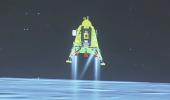
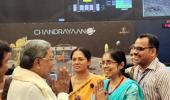
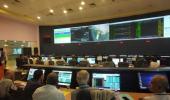



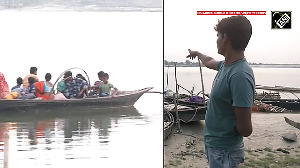
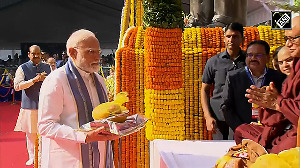

 © 2025
© 2025